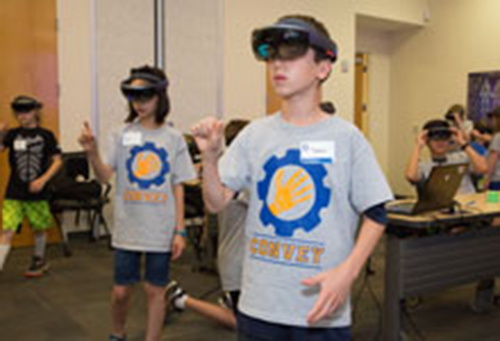
Addressing a crowd of middle- and high-school students, the former U.S. Army Soldier discussed how he lost his arm and leg to combat-related injuries—describing the challenges of using prosthetic limbs to brush his teeth or enjoy recreation like swimming.
The warfighter then turned the conversation over to his young daughter, who said, “One thing my dad never has trouble with is hugging me.” To prove her point, father and daughter gave each other a powerful squeeze.
This poignant moment underscored the human element of a series of science, technology, engineering and math (STEM) workshops recently held by the Johns Hopkins Applied Physics Laboratory (APL) and the Department of Physical Medicine and Rehabilitation at the Uniformed Services University of the Health Sciences in Bethesda, Maryland. The workshops targeted students whose parents are current or former military personnel, and highlighted the science behind prosthetic limbs.
Coordinated by the Johns Hopkins APL, with support from the Office of Naval Research (ONR), the interactive workshops were part of a new initiative titled CONVEY—Connecting STEM Outreach Now Using VIE Education for Youth. (VIE stands for Virtual Integration Environment.)
Johns Hopkins APL created CONVEY through its STEM program to educate children about prosthetic limbs—using virtual- and augmented-reality technology—and spark an interest in future STEM careers.
“An important priority of the Navy and Marine Corps is cultivating the next generation of scientists and engineers,” said Dr. Peter Squire, a program officer in ONR’s Expeditionary Maneuver Warfare and Combating Terrorism Department. “CONVEY represents an excellent opportunity to demonstrate how science impacts and benefits amputees using prosthetics, and to create a personal connection between science and technology and people.”
CONVEY combines specialized software developed by Johns Hopkins APL with commercially available technology—like the Oculus Rift virtual-reality headset and Microsoft HoloLens augmented-reality headset—to teach children about biology, anatomy and engineering.
Virtual reality is a wholly computer-generated environment in which users immerse themselves. Augmented reality, by contrast, superimposes virtual objects onto a real environment—like the yellow first-down lines added to television broadcasts of football games.
During the recent workshops, middle and high school participants used the Oculus Rift to manipulate virtual prosthetic limbs, play computer-generated games like darts and ping pong, and move objects around. They wore the HoloLens headset to study 3-D representations of the human brain, nervous system and muscle groups. Students also learned how new, cutting-edge prosthetics incorporate advanced microcircuits to restore the use of limbs and allow amputees greater control and utility.
“Our objective is to use the virtual training platform to enhance each child’s understanding of how STEM concepts and products are being used to enable personal independence, mobility and human interaction for their loved ones,” said Dwight Carr, who manages the Johns Hopkins APL STEM program. “It’s an engaging and interactive way to expand the use of the technology, while helping both the service members and their families.”
ONR is committed to identifying and attracting young STEM talent—and provides programs for K-12 students designed to build excitement about careers in science and engineering. Carr hopes to host more military-focused workshops in the future, as well as incorporate CONVEY within Johns Hopkins APL’s own STEM outreach in and around Baltimore and Washington, D.C.

